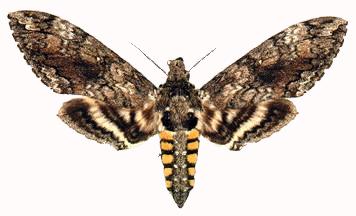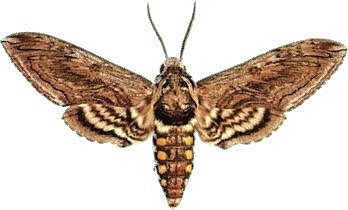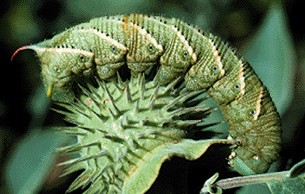Tomato Hornworm, Tobacco Hornworm
 Scientific Name
Scientific Name
Manduca quinquemaculata, Manduca sexta (most common)
Hosts
Homworms feed primarily on solanaceous plants. These, include tobacco, tomato, eggplant, pepper, potato, and certain weeds. Tobacco and tomato plants are preferred for oviposition.
Symptoms
 The larvae consume large amounts of foliage and 2 or 3 large larvae can virtually
defoliate even a large plant. The grower will often see plants with many stems and
leaf veins but with the leaf surfaces completely removed. They will occasionally feed
on the fruit if most of the leaves have been eaten. Rather than boring into the fruit,
they feed superficially leaving large, open scars.
The larvae consume large amounts of foliage and 2 or 3 large larvae can virtually
defoliate even a large plant. The grower will often see plants with many stems and
leaf veins but with the leaf surfaces completely removed. They will occasionally feed
on the fruit if most of the leaves have been eaten. Rather than boring into the fruit,
they feed superficially leaving large, open scars.
Life Cycle
 Homworms overwinter as pupae in the soil. Adults begin emerging in mid-May in most
years. Eggs are deposited on the undersides of leaves at night. Each moth deposits
1 to 5 eggs per plant visit and may lay up to 2,000 eggs. First generation larvae
are present by late May or early June. After feeding for 3 weeks, the larvae burrow
into the soil and pupate. First generation adults are emerging by mid-July and second
generation larvae are present from early August to early October.
Homworms overwinter as pupae in the soil. Adults begin emerging in mid-May in most
years. Eggs are deposited on the undersides of leaves at night. Each moth deposits
1 to 5 eggs per plant visit and may lay up to 2,000 eggs. First generation larvae
are present by late May or early June. After feeding for 3 weeks, the larvae burrow
into the soil and pupate. First generation adults are emerging by mid-July and second
generation larvae are present from early August to early October.
Description
 There are two species of hornworms that feed on tomatoes in Oklahoma. Adults of both
species are large, robust moths, gray or brown in color, with a wingspread of 3 to
5 inches. There are 5 or 6 pairs of yellow or orange spots on the abdomen. They are
referred to as sphinx or hawk moths. The larvae are large, green caterpillars with
white stripes on each side of the body and a horn near the end of the abdomen. They
are at least 3 inches long at maturity.
There are two species of hornworms that feed on tomatoes in Oklahoma. Adults of both
species are large, robust moths, gray or brown in color, with a wingspread of 3 to
5 inches. There are 5 or 6 pairs of yellow or orange spots on the abdomen. They are
referred to as sphinx or hawk moths. The larvae are large, green caterpillars with
white stripes on each side of the body and a horn near the end of the abdomen. They
are at least 3 inches long at maturity.
Tomato hornworm adult is mainly gray in color with a sinuous, black line near the outer margin of the front wings. The hind wings have three black stripes, all well separated. There are usually 5 pairs of spots on the abdomen. The larvae have white, V-shaped markings on the sides of the body and a black horn.
Tobacco hornworm adult is brownish in color with an irregular, usually broken, subterminal line on the front wings. The hind wings have the two middle black stripes partially fused. There are usually 6 pairs of spots on the abdomen. The larvae have white, diagonal lines on the sides of the body and a red horn.
Control
Please contact your local county extension office for current information.
